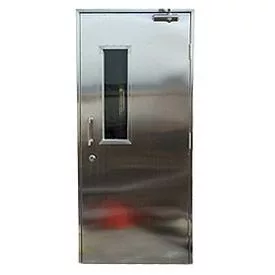Does an Fire Door Need to Be Tested Annually?

By YK Fire Door Manufacturer
Fire protection is not a matter of choice—it is a regulatory and ethical responsibility. Among the many systems integrated into buildings for fire containment, fire doors are among the most critical. These doors serve as automatic physical barriers designed to contain fire and smoke, buying valuable time for evacuation and emergency response. But their mere presence isn’t enough. The real question is—do overhead fire doors require annual testing? For property owners and facility managers, the answer should be unequivocal: yes.
Importance of Fire Door Test
Overhead fire doors, often installed in commercial and industrial settings, are engineered to deploy automatically during a fire event. Whether it’s a logistics center, a manufacturing floor, or a high-traffic public building, these systems are built to isolate danger and protect fire exit routes. Like other fire rated door solutions—such as fire rated steel doors, fire rated wood doors, and steel commercial doors—these assemblies are only as effective as their operational readiness.
Over time, mechanical fatigue, environmental exposure, or improper use can degrade performance. Compliance with building regulations fire doors requires not just installation, but ongoing validation. At YK Fire Door Manufacturer, we emphasize that ensuring door closer fire regulations are met is as important as choosing the right wooden fire resistant doors or 90 minute fire rated wood doors.
The Regulatory Mandate: Annual Testing under NFPA 80
NFPA 80, the authoritative standard for fire door assemblies, mandates that all fire doors—including overhead models—undergo full inspection and testing at least once per year. This requirement is not optional. It is embedded in fire codes across jurisdictions and echoed in Fire Door Certificate protocols recognized internationally.
More than a box-checking exercise, annual testing uncovers malfunctions that may compromise the door’s ability to activate under heat, smoke, or flame. It also validates the integrity of seals, tracks, counterweights, and release mechanisms—especially important for automated systems integrated with alarm or smoke detection networks.
What Annual Fire Door Test Really Involves
A certified inspection goes beyond a surface check. At YK Fire Door Manufacturer, our team of licensed technicians performs a structured evaluation that reflects both fire door regulations and best practices outlined in interior fire door standards. Each test includes:
- Operational Testing: Confirming that the door opens, closes, and auto-activates without mechanical interference.
- Seal and Gasket Check: Ensuring that intumescent seals create an airtight barrier during thermal expansion.
- Hardware Assessment: Examining hinges, guides, limit switches, and other mechanical elements.
- Manual Override Functionality: Testing redundancy systems that comply with door closer fire regulations.
- Fire Resistance Validation: Reviewing fire-rated markings, expiration periods, and fire rated interior doors rating compliance.
This level of precision is especially vital for wooden fire doors used in retail, hospitality, or residential settings, where interior finishes and aesthetic elements must harmonize with robust protection.
How Often Do Fire Doors Need to Be Inspected?
When it comes to fire safety, installing fire rated doors is only the first step. Proper maintenance and regular inspections ensure these critical components perform reliably during emergencies. At YK fire door manufacturer, we understand the importance of keeping every fire rated wood door, steel commercial door, and fire rated interior door in optimal working condition. As industry regulations evolve, understanding inspection timelines and requirements becomes increasingly vital.
Annual Inspection Requirements for Fire Door test
According to building regulations for fire doors and the standards set by the National Fire Protection Association (NFPA), all fire doors must undergo inspection at least once a year. This includes fire exit doors, fire rated steel doors, and wooden fire doors. NFPA 80 outlines the essential components of an annual fire door inspection, including a drop test, visual assessment, and operational evaluation. These inspections apply across all fire rated door types, from 90 minute fire rated wood doors to steel commercial overhead fire doors.
What Does the NFPA 80 Inspection Include?
NFPA 80 mandates three types of evaluations: visual inspection, operational testing, and drop testing. The visual assessment identifies any visible damage to the door leaf, frame, or hardware. Labels must be legible, and parts such as fusible links and cables must not be painted or coated. Operational testing ensures that the fire rated door opens and closes correctly. Drop testing confirms that the door automatically closes upon fire alarm activation. For doors to remain code-compliant, each component must pass its respective evaluation.
Why Annual Inspections Matter
Inspecting fire doors annually is not merely a regulatory obligation—it’s a safeguard for life and property. Fire rated wood doors and wooden fire resistant doors often experience wear over time. Without consistent inspections, issues like unbalanced closing, worn-out seals, or delayed response mechanisms may go unnoticed. YK fire door manufacturer encourages building owners and managers to adhere to these standards not only for compliance but also for the long-term integrity of their safety systems.
Fire Door Certificate and Documentation
Every certified fire rated door should have a valid Fire Door Certificate, ensuring compliance with fire door regulations. This certification documents the fire rated interior doors rating and validates that the product meets interior fire door standards. Technicians performing inspections should log all findings, including door location, fire rating, and testing date. These records should be maintained for at least three years and be available to the Authority Having Jurisdiction (AHJ) upon request.
Choosing a Qualified Fire Door Inspector
Hiring a qualified technician to conduct annual inspections is essential. Experience, training, and knowledge of fire door drop testing and relevant building regulations for fire doors are crucial qualifications. Technicians should follow NFPA 80 procedures and understand nuances related to each door type, whether it’s a wooden fire door, fire rated steel door, or UL fire door.
Common Issues Found During Inspection
Frequent problems discovered during inspections include:
- Misaligned tracks
- Damaged or missing labels
- Defective closing mechanisms
- Debris in the guide paths
- Seal degradation
Such defects compromise the fire door’s effectiveness and must be resolved immediately to maintain certification and safety.
Ongoing Maintenance Beyond Annual Checks
YK fire door manufacturer recommends ongoing visual checks throughout the year. Maintenance staff should monitor steel commercial doors and fire rated wood doors for obstructions, unusual wear, and proper functioning of automatic features. By combining annual professional inspections with routine in-house checks, building owners can extend the lifespan of their fire safety equipment.
Conclusion
Fire doors, whether they are fire rated wood doors, UL certified steel commercial doors, or wooden fire resistant doors, play a critical role in passive fire protection. At YK fire door manufacturer, we support clients in maintaining full regulatory compliance through high-quality products and reliable inspection guidance. Keeping fire door certificates updated and ensuring regular evaluations are performed can significantly impact safety, legal liability, and operational longevity.

Pingback: What are the items for fire door inspection? - YK | Fire Doors | Fire Windows | Fire Shutters